programa
Association rule mining has become essential for businesses aiming to understand customer behaviors and purchasing patterns. This technique identifies items frequently bought together, helping companies optimize product placement, promotions, and recommendations. Such analysis improves business strategies by clearly revealing trends hidden within transaction data.
The Apriori Algorithm is a popular method for mining these association rules because of its simplicity and practical results. Unlike other complex methods, Apriori is straightforward, making it suitable for beginners and effective in real-world applications.
This article explains the Apriori algorithm, illustrates its workflow with clear examples, and shows you how to use it effectively. If you want to get hands-on with machine learning concepts, check out our Machine Learning Scientist in Python career track.
What is the Apriori Algorithm?
As you will discover from our Association Rule Mining in Python Tutorial, Apriori is an algorithm designed to extract frequent itemsets from transactional databases and generate association rules. It is based on the principle that if an itemset is frequent, all its subsets must also be frequent. This assumption helps reduce the number of possible itemsets that need to be checked, making the process efficient.
Itemsets and transactions
A dataset for Apriori typically consists of transactions, where each transaction is a collection of items purchased together. For example, a supermarket's sales data may contain transactions such as:
- Milk, Bread, Butter
- Milk, Diaper, Beer, Bread
- Diaper, Beer, Butter
Each of these transactions represents a basket of items bought in a single purchase. Our Market Basket Analysis in Python course goes into more detail about the application of this concept in Python.
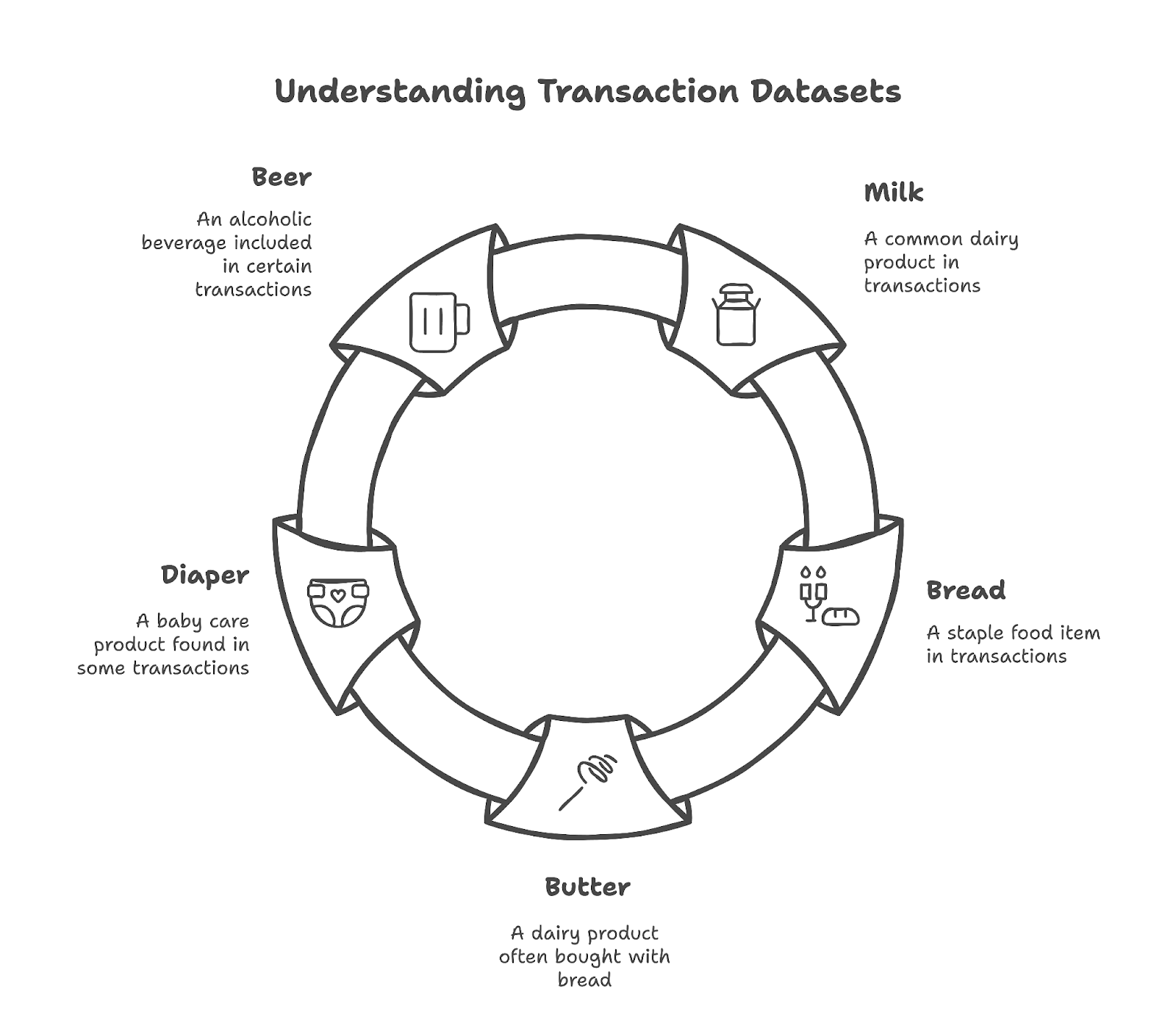
Support, confidence, and lift
Association rule mining relies on three key metrics:
Support: The frequency with which an item appears in the dataset. It is calculated as:

Confidence: The likelihood that item B is purchased when item A is purchased, given by:

Lift: The strength of a rule, measuring how much more likely item B is bought when item A is bought compared to when bought independently:

A lift value greater than 1 suggests a strong positive association between items.
How the Apriori Algorithm Works
Let’s now discover how the Apriori algorithm works.
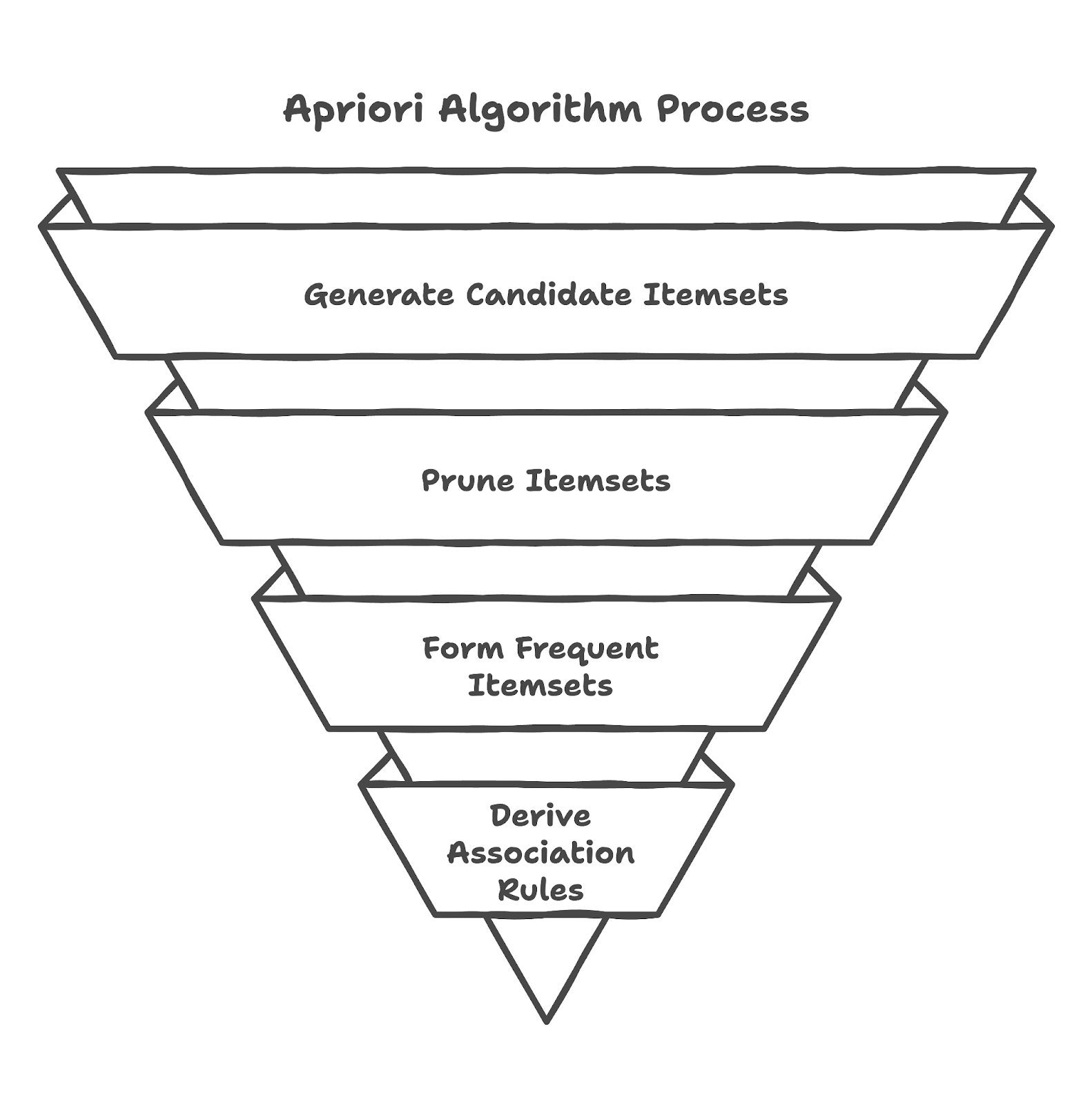
Step-by-step process
- Generating candidate itemsets: The algorithm starts by identifying individual items and counting their occurrences to determine frequent items.
- Pruning based on minimum support: Itemsets that appear less than the minimum support threshold are removed.
- Generating frequent itemsets: The algorithm generates larger itemsets by combining frequent smaller itemsets, iterating until no more frequent itemsets can be formed.
- Deriving association rules: It extracts rules based on confidence and lift values to determine meaningful relationships.
Example walkthrough
Consider a dataset with transactions:
- Milk, Bread
- Milk, Butter
- Milk, Bread, Butter
- Bread, Butter
Using a minimum support of 50%, the algorithm identifies frequent itemsets and extracts rules such as:
- Milk → Bread: Confidence: 66.7%
- Bread → Butter: Confidence: 66.7%
These rules help businesses understand purchasing behaviors and optimize their inventory.
Implementing the Apriori Algorithm in Python
In this section, you learn how to implement the Apriori algorithm in Python.
Setting up the environment
To use Apriori in Python, install the necessary libraries:
pip install mlxtend pandasLoading and preparing data
The next step is to load packages and prepare the data:
import pandas as pd
from mlxtend.frequent_patterns import apriori, association_rules
# Expanded dataset
data = {
'Milk': [1, 1, 0, 1, 0, 1, 0, 1, 1, 0],
'Bread': [1, 0, 1, 1, 1, 0, 1, 0, 1, 1],
'Butter': [0, 1, 1, 1, 1, 1, 0, 1, 1, 0],
'Eggs': [1, 0, 0, 1, 1, 1, 1, 0, 0, 1],
'Cheese': [0, 1, 1, 0, 1, 1, 0, 1, 0, 1],
'Diaper': [0, 1, 0, 1, 0, 1, 1, 1, 0, 0],
'Beer': [1, 0, 1, 0, 1, 0, 1, 0, 1, 1]
}
df = pd.DataFrame(data)Applying the Apriori algorithm
Next, apply the algorithm.
# Generating frequent itemsets
frequent_itemsets = apriori(df, min_support=0.5, use_colnames=True)Then, we obtain the association rules:
# Generating frequent itemsets
frequent_itemsets = apriori(df, min_support=0.5, use_colnames=True)
# Generating association rules
rules = association_rules(frequent_itemsets, metric='confidence', min_threshold=0.6)
print(rules[['antecedents', 'consequents', 'support', 'confidence', 'lift']])
antecedents consequents support confidence lift
0 (Butter) (Milk) 0.5 0.714286 1.190476
1 (Milk) (Butter) 0.5 0.833333 1.190476
2 (Bread) (Eggs) 0.5 0.714286 1.190476
3 (Eggs) (Bread) 0.5 0.833333 1.190476
4 (Bread) (Beer) 0.6 0.857143 1.428571
5 (Beer) (Bread) 0.6 1.000000 1.428571
6 (Butter) (Cheese) 0.5 0.714286 1.190476
7 (Cheese) (Butter) 0.5 0.833333 1.190476The support values (0.5 to 0.6) indicate that these associations appear in 50-60% of all transactions.
The confidence scores (0.71 to 1.0) show the reliability of the rules, with some like Beer → Bread being certain (100% confidence).
The lift values (~1.2 to 1.4) suggest moderate but meaningful associations, indicating these pairs of items occur together somewhat more frequently than random chance.
Interpreting the results
To better understand the association rules generated by the Apriori algorithm, we can visualize them using Matplotlib. A scatter plot helps in examining confidence versus lift, while a heatmap shows support for various item combinations.
import matplotlib.pyplot as plt
import networkx as nx
# Scatter plot of confidence vs lift
plt.figure(figsize=(8,6))
plt.scatter(rules['confidence'], rules['lift'], alpha=0.7, color='b')
plt.xlabel('Confidence')
plt.ylabel('Lift')
plt.title('Confidence vs Lift in Association Rules')
plt.grid()
plt.show()
# Visualizing association rules as a network graph
G = nx.DiGraph()
for _, row in rules.iterrows():
G.add_edge(tuple(row['antecedents']), tuple(row['consequents']), weight=row['confidence'])
plt.figure(figsize=(10, 6))
pos = nx.spring_layout(G)
nx.draw(G, pos, with_labels=True, node_color='lightblue', edge_color='gray', node_size=3000, font_size=10)
edge_labels = {(tuple(row['antecedents']), tuple(row['consequents'])): f"{row['confidence']:.2f}"
for _, row in rules.iterrows()}
nx.draw_networkx_edge_labels(G, pos, edge_labels=edge_labels)
plt.title("Association Rules Network")
plt.show()The scatter plot helps identify rules with strong relationships, while the network graph visually represents how different items are associated. These insights guide decision-making in retail, recommendations, and fraud detection.
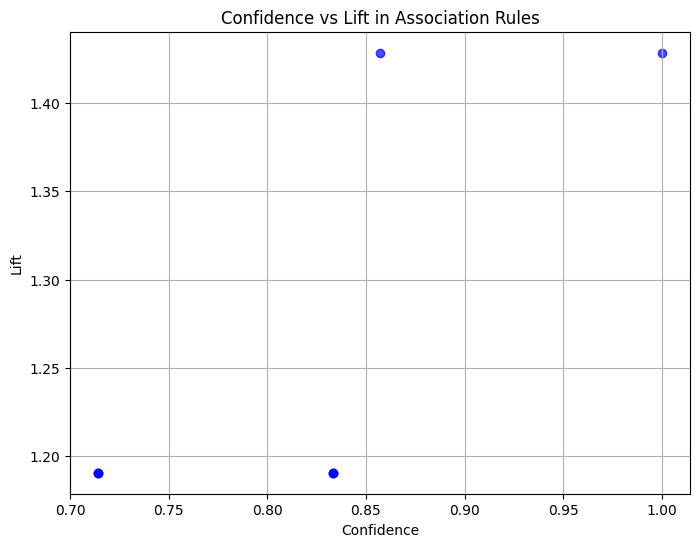
The scatter plot shows the relationship between confidence and lift for the association rules generated. The key observations are:
- The data points are spread between a confidence range of 0.7 to 1.0.
- The lift values mostly fall between 1.19 and 1.43, indicating that the identified rules provide some level of meaningful association but are not extremely strong.
- A confidence value of 1.0 with a lift of 1.43 (Beer → Bread) suggests that whenever beer is purchased, bread is always present in the transaction, making it a highly reliable rule.
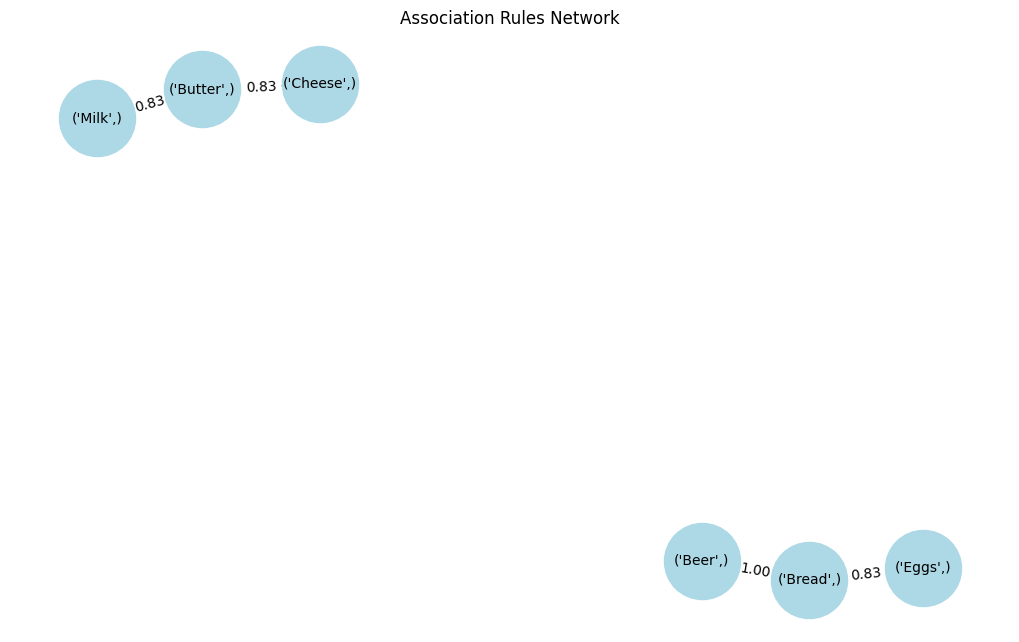
The network graph visually represents the associations between different items:
- Milk and Butter are strongly associated, meaning customers who buy one are likely to buy the other.
- Bread and Eggs have a similar relationship, indicating a common buying pattern.
- Beer and Bread show the strongest confidence (1.0), meaning that in all transactions where Beer appears, Bread is always present.
Applications of the Apriori Algorithm
Businesses widely apply the Apriori algorithm to solve various problems. Let’s discover them below.
Market basket analysis
Retailers use Apriori to analyze purchase patterns, helping them arrange products to encourage combined purchases. For example, if bread and butter frequently appear together, a store may place them in close proximity to boost sales. Learn more about market basket analysis from our market basket analysis using R tutorial.
Recommendation systems
Online platforms use Apriori to suggest products based on previous purchases. If a customer buys a laptop, recommendations may include accessories like a mouse or a keyboard.
Anomaly detection
In fraud detection, Apriori identifies unusual transactions by comparing them to expected patterns. If a credit card transaction deviates significantly from established rules, it may trigger a security check. In anomaly detection, while Apriori is not directly used to identify anomalies, it can help detect rare or unexpected item combinations that deviate significantly from common purchasing patterns.
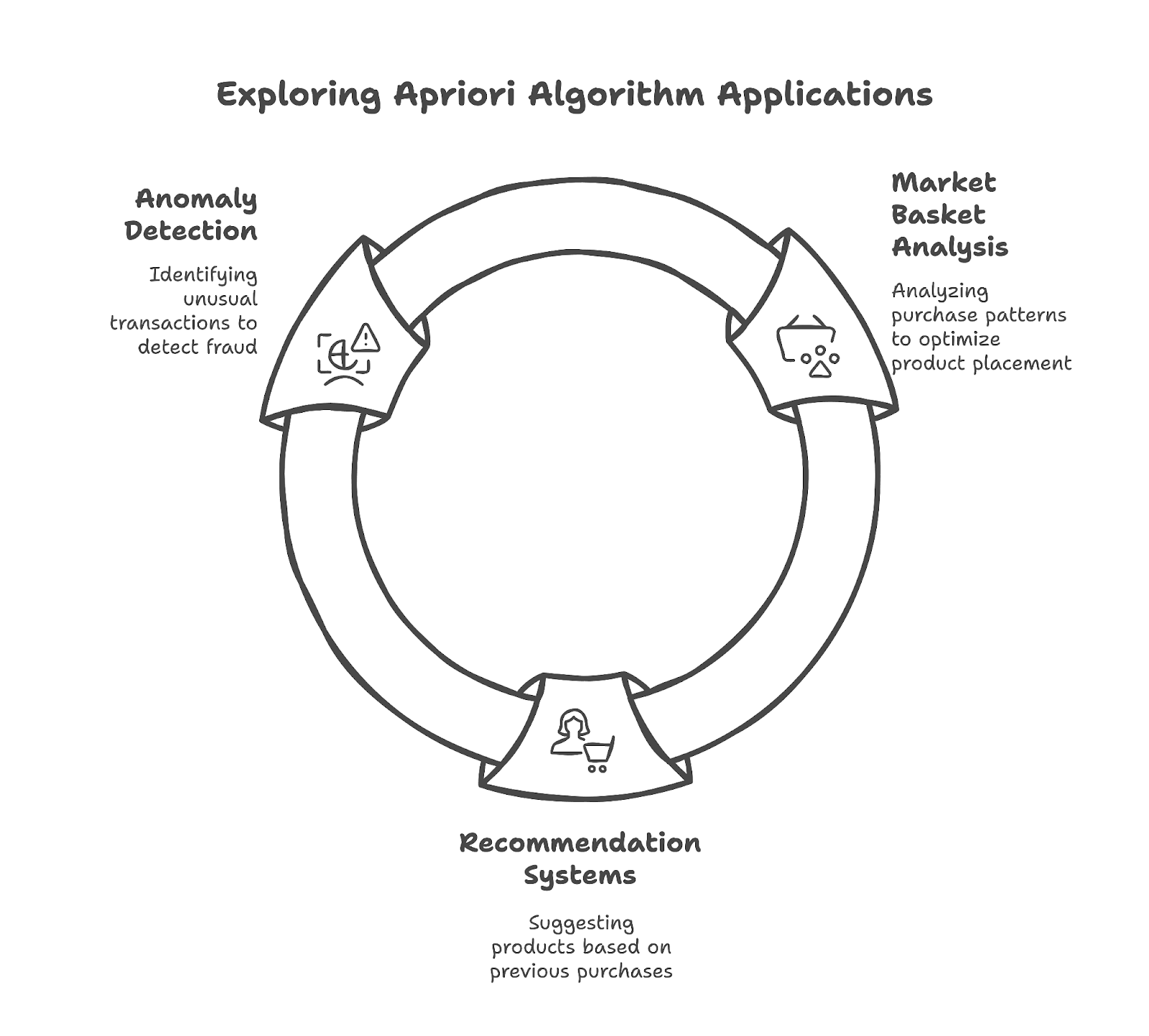
Advantages and Limitations
There are several advantages and disadvantages of using the Apriori algorithm, as you will discover below.
Advantages
Apriori is simple to understand and effective at discovering frequent itemsets in structured datasets. It is widely used in industries like retail and healthcare for pattern discovery.
Limitations
The algorithm becomes slow when working with large datasets because it generates many candidate itemsets. In cases with a high volume of data, alternative methods like FP-Growth offer better performance.
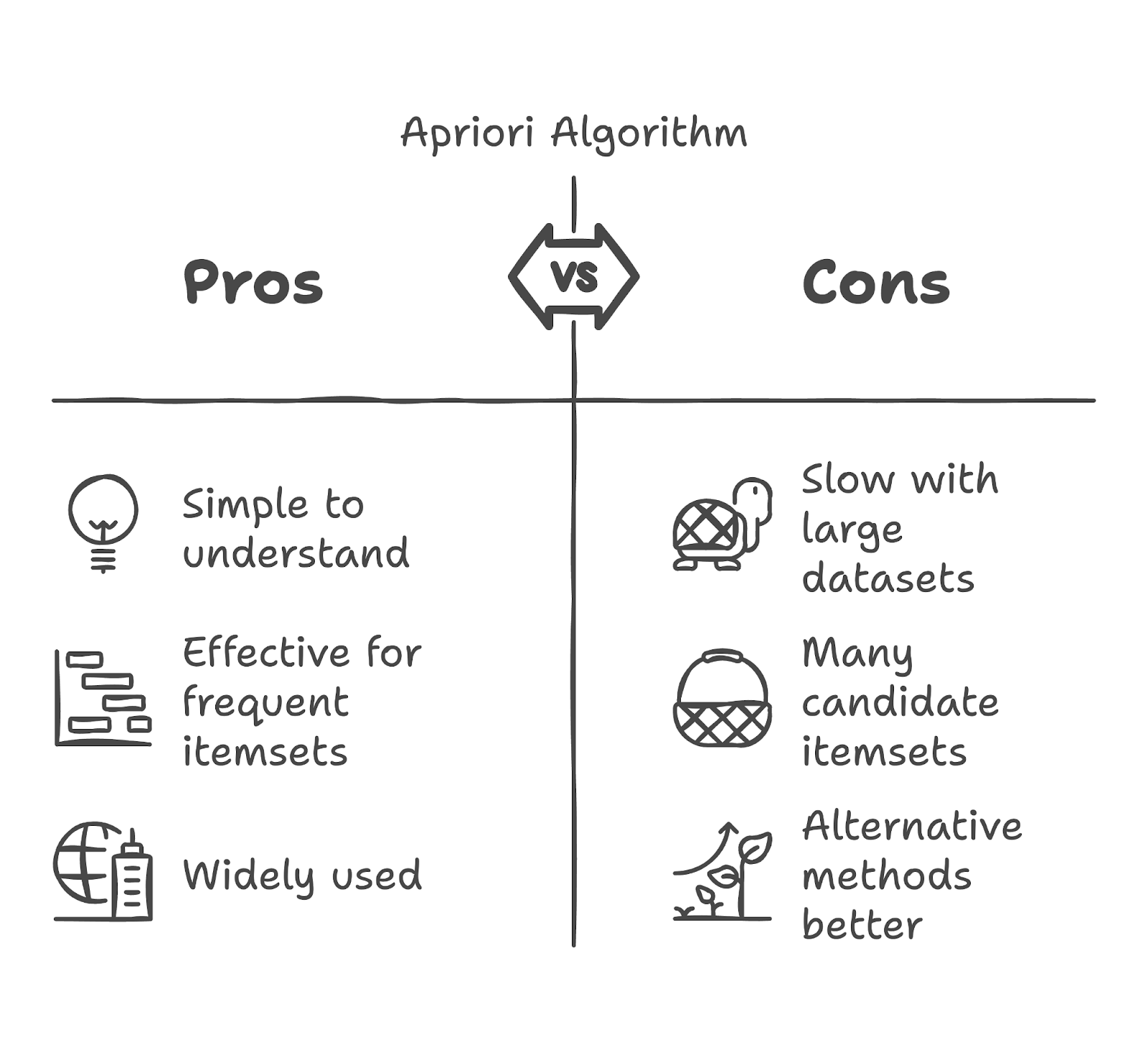
Conclusion
Apriori remains one of the most useful techniques for finding associations in data. Despite its computational challenges, it provides valuable insights that businesses use to enhance customer experiences and increase sales.
While it may not be the fastest approach for large datasets, it remains an essential tool in the field of data mining, analytics, and machine learning. To learn more, explore machine learning with Python and work toward becoming a machine learning scientist with our Machine Learning Scientist in Python career track.
Apriori Algorithm FAQs
What is the Apriori algorithm used for?
The Apriori algorithm is used in data mining to identify frequent itemsets and generate association rules from large datasets. It is commonly applied in market basket analysis, recommendation systems, and fraud detection.
How does the Apriori algorithm work?
Apriori works by first identifying frequently occurring individual items in a dataset and then generating larger itemsets based on these. It prunes itemsets that do not meet a minimum support threshold and derives association rules using confidence and lift metrics.
What are support, confidence, and lift in Apriori?
Support: The frequency of an itemset in the dataset.
Confidence: The probability that an item appears in a transaction given the presence of another item.
Lift: The strength of the association, indicating whether items are bought together more often than expected.
What are the limitations of the Apriori algorithm?
Apriori can be slow when working with large datasets due to the high number of candidate itemsets generated. It also struggles with dense datasets where many items frequently appear together. The FP-Growth algorithm is an alternative that performs better in such cases.
What is the difference between Apriori and FP-Growth?
Apriori generates candidate itemsets and checks their support iteratively, making it computationally expensive. FP-Growth, on the other hand, uses a tree structure to reduce the number of candidate itemsets, making it faster for large datasets.
